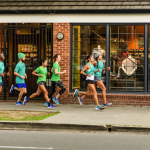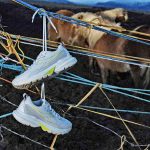Ask an outdoor retailer or apparel brand manager to identify mistakes and problem areas in lifestyle apparel merchandising, and they will quickly start to tick them off, 1-2-3-4-5. The list is long.
Our panel of experts suggests that by paying more attention to effectively merchandising lifestyle apparel, specialty retailers can generate significant sales increases.
According to Dan Butler, National Retail Federation VP of merchandising and retail operations, “One of the common mistakes retailers make is putting apparel on a rack and treating it as another commodity in the store.”
Nicole Lockridge, director of business development at The Carlson Group, a retail marketing services company that offers POP displays, fixtures and complete custom store environments, provides a broader point of view.
“One of the most common mistakes we see among retailers is too much apparel on the racks,” Lockridge says. “Overcrowded walls and floor displays frustrate shoppers and dilute the brands and retailers message. Another common mistake we see too often is using the same height for all floor fixtures-a sea of evenness. The shopper needs to see from the front to the back of the shop. The back row or back wall of displays should be visible from the perimeter of the shop. Too much uniformity is boring and projects a lack of creativity on the brand and retailer.”
Brigitte Kirchgatterer, Mountain Hardwears visual merchandising manager, travels around the country assisting specialty retailers with apparel marketing. She sees two approaches: “[First are] shops that just wont change or dont see a need for change and cannot figure out why the bottom line is slowly slipping away. Second are shops that saw the consumer shift coming and are actively seeking new methods to reach both old and new consumers.” She adds, “When we work with shops that have embraced this new, non-technical customer, we work with them to implement logical floor planning to include and introduce fashion while on the way to function.”
Shifting the perspective from the displays to the consumer, Steve Kaufman, editor of Visual Merchandising and Store Design magazine, says, “The biggest mistake is not fully understanding the person who walks through the door and what that person expects, wants, and what will drive that person to make a purchase. Retailers think the customer is so sophisticated that all you have to do is show them a tag and you have them. A lot of retailers dont understand the simple concepts of merchandise presentation,” he says. “The way you present merchandise can make a huge difference. As a consumer walks in, they are making a series of instant decisions. Which way do I turn? Am I finding what Im looking for? Do I think they will have what I need? Any retailer needs to guide them through that process.”
PRESENTING THE COLLECTIONS
Its not all doom and gloom when discussing apparel merchandising. Vendor support and fast-learning specialty retailers have created displays that outdoor enthusiasts cant pass up without making a purchase or two. Although their customers also shop at department and apparel specialty stores, outdoor retailers can compete successfully.
Kirchgatterer comments, “For the outdoor specialty retailer to remain relevant and even increase their share of the consumer dollars, they need to up the ante to be different. Specialty retailers need to realize that they must take hold of all the intangibles related to their brand, like staff education and enthusiasm and passion regarding fashion as well as technical product, and really capitalize on the very modern, educated, savvy consumers desire to remain part of their brand tribe.”
Steve Bendzak, GM of ExOfficio, adds, “[Outdoor retailers] can compete with the Gap by having unique performance-oriented fabrics in lifestyle silhouettes. Thats key. Its important that there is an additional benefit to the end-user with the products carried in specialty stores. It cant just look cool-it has to work.”
Sierra Designs apparel product manager, Melodie Miller, even offers a few tips to help sales associates get on the right track.
“First, think about how you are going to get dressed yourself. What are you going to wear? You are going to put something together that is appropriate for the day, the activity, and will make you feel good about yourself,” Miller explains. “Next, show a complete outfit. A person may be interested in the outfit, or several pieces of it, because they have similar pieces at home. You have to show the apparel on the manikin or hanging together near the garments so the customer can access them quickly. The more instructions and more identification at the site of the outfit, the better.”
Once rarely seen, the ubiquitous manikins found in major apparel stores are becoming as common as campsite mosquitoes in the outdoor world. Bendzak, who is a strong proponent of using human forms, says, “ExOfficio provides manikins at cost or free, based on the retailers commitments to the brand. The most important thing is to be able to show the apparel on a high-quality manikin rather than having the garment just hang on a hanger.”
Deciding what the manikins should wear opens up another complicated set of decisions. Brands that offer complete lines may suggest that the manikins should only present their collections. Retailers may feel the most effective display is a combination of the best each brand has to offer.
Tami Snow, Horny Toad marketing director, says, “The more sophisticated the buyer is, the more they are thinking about how it will come together and what it will look like in the store. The process can be more difficult when you are looking at different manufacturers.”
Bendzak offers, “The rule of thumb is to always have three layers on the manikin so you are selling multiple items. Whatever is on the manikin is, in most cases, what will sell.”
Bendzak supports blending brands as long as the retailer takes a sophisticated approach. “I think its beneficial,” he says. “It shows the versatility of the products the retailer carries. The specialness of what a retailer carries can be shown with cross-merchandising. There are a number of brands that would certainly be upset with cross-merchandising, yet thats how this consumer, in many cases, lives.”
Mike Massey, owner of Masseys Outdoors, understands that mindset. “We try to cross-merchandise lifestyle and technical apparel together,” he says. “We dont break it down as distinct things. We try to make the presentation be in sync with how customers shop.”
One critical point outdoor retailers can learn from other apparel stores is the importance of changing the look of the store frequently. Miller recommends changing collections weekly. “One of the ways to compete is to make your store look new as often as possible, even if it is the same product,” she notes.
Snow adds, “Technical products have specific points of reference to talk about. Lifestyle [apparel] is feelings and personalities. Keeping those pieces fresh will drive that customer to keep coming back to the store. Its incredibly important as they compete with mass merchandise stores. Little suggestions about placement and presentation can influence a customer to pick something up.”
A selection of brands also helps keep apparel looking fresh. “The store has to keep looking fresh to be successful,” observes Beth Steele, director of sales at Orage. “The key to success moving forward is getting [retailers] to align themselves with brands that perform well in certain windows, and get them to commit to bringing in more new products in more months of the year.”
Kaufmann reminds retailers to pay attention to administrative details as well. He says, “Make sure the new deliveries are on the floor right away and the apparel is sized correctly. By helping the customer with what they are looking for, they will have more time to buy more product.”
CREATING AN ENVIRONMENT
If specialty retailers are going to increase apparel sales, the days of packing a chrome rounder with technical jackets organized by size and color are over.
“So often, retailers reach for the low-hanging fruit and overfill inexpensive, high-capacity fixtures with like product in an attempt to make it easier for the customer to find an item. But the key here would be an item. Effective merchandising and the creation of an exciting atmosphere can make the difference between a customer approaching the cash-wrap with a single item versus a collection of items,” Kirchgatterer says.
Apparel displays serve as much more than places to hang a shirt, jacket or pair of pants. As Bendzak points out, “Its just not as simple as putting a manikin out there. Its cross-merchandising with packs, or using a table with books or other items. [Merchandising requires] creating an environment with emotion using products from other parts of the store and images of people or places that drive an emotional response.”
Dianne Morgan, manager/buyer at The Base Camp in Billings, MT, explains her approach: “We try to use the display to tell a story. If it is a wall display featuring hiking clothing, we use hiking boots and a hiking guidebook to complete the idea. If the clothing is casual ladies sportswear, we use a sunhat or handbag. We also try to keep lots of manikins dressed in multiple layers around the store.”
Vendors such as Horny Toad, Sierra Designs, Mountain Hardwear, Gramicci and ExOfficio offer retailers apparel merchandising support services ranging from display fixtures to complete apparel environments and face-to-face consulting.
Gramicci offers customers the Visual Merchandising Matrix: three-dimensional renderings showing retailers what it takes to represent the product in the proper way. Gramicci president Marty Weening explains, “It guides the buyer that is indecisive about how to take the product and make a meaningful enough statement to succeed. Were telling the buyer precisely what is necessary to quickly and easily assess how to present the proper impact and impression on their customer. Wherever this has been implemented, our business has doubled, tripled or quadrupled.”
Kirchgatterer points out that, depending on purchasing levels, Mountain Hardware retailers can participate in the brands Preferred Equipment Dealer, Brand Shop or Focus Fixture programs. All are designed to improve apparel presentations and provide sales associates with merchandising support.
Launched in 2007, Horny Toads Dealer Tool helps apparel buyers bring in a good assortment and tell the brands color story. “The Dealer Tool will help them relate that vision to the floor staff in a visual way,” says Snow. “Fifteen retailers are participating and we are teaching them how to review sales information, cross-reference their buy, and give them suggestions how to improve sell-through.”
But outfitting a store with display fixtures can be expensive. Many retailers ponder the balance between vendors offerings and a stores unique look.
“Its a huge dilemma,” notes Kaufman. “Its a fundamental problem, especially for the small retailers who rely on their vendors. The average small retailer doesnt have the staff to dress a manikin or put a presentation together. They are dependent on the vendor for that material. But what they sacrifice is their own branding and identity.”
Chris Howe, a partner in New Haven, CT-based Trailblazer LLC, remarks that, “Early on, we were much more prone to taking advantage of a vendors merchandising aids. As weve evolved, weve found it more beneficial to develop our own merchandising system, graphics and signage to support all of it. It creates an atmosphere that is exclusive to Trailblazer and not something that you could walk into in any other outdoor store and get a similar feel.”
At Idaho Mountain Touring in Boise, ID, owner Chris Haunold says, “Were moving toward actually creating our own fixtures and not using many of the vendors fixtures. We want our look; not their look.”
The Base Camps Morgan agrees. “Our stores have strong interior designs that feature an outdoor, natural feel, and we want the product and stories to speak for themselves,” she says. “So we try to limit the vendor fixtures and only use them when the fixture helps sell the product because it lends a certain organization, such as an underwear fixture.”
Massey sees value in both approaches. “We use the manufacturer fixtures but thats not the end of the story for us. Each store has a slightly different personality. We try to avoid using pre-packaged stuff and look for something that is going to be interesting for the people when they walk in,” he explains. “Its the difference between a coffee shop that tries to be Starbucks, and being the coffee shop that screams local. Were trying to create a look that says something about your connection to the community rather than trying to look like a chain.”
Toward this end, Masseys built its own welding shop to manufacture fixtures that are being used in a recently opened store. For example, a hood salvaged from a wrecked car is now an apparel display table.
Fixtures from vendors have been designed for specific applications and reflect an understanding of most specialty retailers opinions about basic design. Exploring options available from other resources can be challenging. Nevertheles, Howe suggests, “Investigate the [custom] fixture companies versus buying stock from a distributor. It really got us thinking about whats important to us in terms of functionality and aesthetics. Admittedly, it costs a little bit more to produce these fixtures. In the end, we were left with a product that we took care of. When [we had] stock fixtures, people just abused them because they [werent] special.”
Howe also recommends incorporating large-format graphics and signage with the fixturing because “it creates an environment that has more impact.”
GENDER RULES
Acknowledging that men and women have different purchasing behaviors requires addressing those variations in apparel merchandising.
“Having distinctive displays for men and women is critical,” states Bendzak. “In the womens department, you will find that more manikins always sell more product. Making sure there are mirrors at the ready-not just in the dressing rooms, but on the retail floor for people to be able to see how they look in the garment-is very important.”
Miller adds, “We are going through a period of strong femininity in our styling. We relate to something as cute. It needs to be presented that way. How you embellish the outfit, how you put the pieces together, and the colors presented make a difference.”
Masseys has seen strong growth in womens apparel, and staying in tune with female customers preferences has been a contributing factor. “We are asking our customers what they want. Were trying new things and seeing whats working. The more we know about what our customers want, the more we can keep our merchandising selection in line with their thinking,” says Massey.
On the mens side, Gramiccis Weening comments, “The key is appealing to the mens sense of core product. The stuff he wants to wear day in and day out. Men are creatures of habit and have favorite things in their wardrobes. The retailer that says, I dont really want to carry five colors in a great T-shirt because it takes up too much space, really has the wrong mentality. If you show five, the guy will buy three. If you show two, he may buy one or none.” He adds, “If the message isnt powerful enough, you wont win over the customer. The more you believe in it, the more your customer will believe it. Perception is a big part of the game.”
HIRING FASHIONISTAS
Outdoor retailers can communicate technical information as well as any brands head designer. But when the conversation turns to fashion merchandising, that expertise can falter. “We can absolutely batter someone into submission with techno-babble,” says Idaho Mountain Tourings Haunold.
“They [outdoor retailers] may have a buyer who is very competent at technical products but may not know apparel as well,” adds NRFs Butler.
Over time, Masseys has changed its fundamental approach in dealing with consumers. “Our general philosophy is that we dont try to determine how hardcore a person is when they walk in the door. Selling casual isnt a problem for us. In fact, we are casual until they want to talk technical,” Massey says.
The shift in attitude came about, says Massey, when “we saw ourselves competing as the technical gurus five years ago. We wanted our shopping sessions [with customers] to be all about downloading information to our customers. We would overwhelm them with details to prove to them that this is exactly the boat or sleeping bag they needed. Now,” he explains, “we go for more of an emotional sale. It is very easy to shop in the store. We really hold back on the technical stuff, recognizing that a huge percentage of the population does not want to be barraged or belittled or made to feel like they are asking stupid questions.”
Massey adds, “Youre discriminating against a huge part of the demographic when you immediately-from the moment they walk in the door-stick your nose up and say you are a hardcore gear store. Were trying to be very approachable. Managers in the store should be like good waiters. They should be available, but out of peoples faces when they arent asking questions.”
Howe notes that Trailblazer hires merchandising staff from other fashion retailers. “Its hard to find someone from the outdoor channel with an extensive history with merchandising,” he says. “We have a regional manager with a strong merchandising background that supervises four locations. One person at each store is in charge of executing a merchandising plan.”
Education also plays an integral role. “The staff has to be educated on the brand so they can tell a story so the consumer feels like they are discovering something,” remarks Bendzak. “If all they can say is, This is a cool shirt, check it out, you are not offering the relationship that the brand or retailer wants with the consumer. Its the relationship that brings the customer back.”
Setting clear expectations with sales associates about the role lifestyle apparel plays in generating sales can prevent inattention. Haunold states, “We reinforce to the staff that [apparel] is an important part of our business. Its not hardcore technical, but its very important and they need to treat it as such.”
MAKING MONEY IS ALWAYS FASHIONABLE
Vendors, retailers and industry observers agree that apparel merchandising has a clear impact on the bottom line. When Trailblazer opened new locations that permitted more apparel displays, sales remained the same with just two-thirds of the square footage.
Lockridge of The Carlson Group says, “Given the current economic climate, the power of retail and its influence on the consumer has become even more critical. A cohesive in-store approach, and leveraging in-store programs and visual merchandising strategies, will increase sales, improve sell-through of key brands, and improve annual product turns.”
Consumers can purchase lifestyle apparel from many retailers. Why not outdoor specialty?
As Massey points out, “If you own the customer for the shirt and pants, where do you think they are going to buy the tent?” Weening adds, “The consumer is much more discerning in how they spend their dollar. Weve got to do more to get it. Thats the bottom line.”
Fashions may change, but the profits are evergreen. “This is the future,” says Steele. “The shops that do this the best will be the most successful.”
In addition, concludes Bendzak, “Theres always more a manufacturer can do with a willing retailer.”















